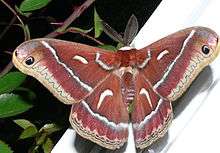Hyalophora euryalus
Hyalophora euryalus, the ceanothus silkmoth, is a moth of the family Saturniidae. It is found in the dry intermontane valleys and interior of British Columbia, Canada, (as far north as Prince George along the Fraser River) south to Baja California in Mexico. The species was first described by Jean Baptiste Boisduval in 1855.
| Hyalophora euryalus | |
|---|---|
 | |
| Scientific classification | |
| Kingdom: | Animalia |
| Phylum: | Arthropoda |
| Class: | Insecta |
| Order: | Lepidoptera |
| Family: | Saturniidae |
| Genus: | Hyalophora |
| Species: | H. euryalus |
| Binomial name | |
| Hyalophora euryalus Boisduval, 1855 | |
| Synonyms | |
| |
The wingspan is 89–127 mm. Adults are on wing from January to July depending on the location. There is one generation per year.
The larvae feed on Ceanothus, Rhamnus californica, Prunus emarginata, Arctostaphylos, Alnus, Betula, Corylus, Ribes, Pseudotsuga menziesii, Arbutus menziesii and Salix.
External links
- Robinson, E.; Schmidt, B. C. "Species Page - Hyalophora euryalus". Entomology Collection. University of Alberta E.H. Strickland Entomological Museum. Retrieved November 11, 2018.
- Lotts, Kelly & Naberhaus, Thomas (2017). "Ceanothus silkmoth Hyalophora euryalus (Boisduval, 1855)". Butterflies and Moths of North America. Retrieved November 11, 2018.
This article is issued from Wikipedia. The text is licensed under Creative Commons - Attribution - Sharealike. Additional terms may apply for the media files.